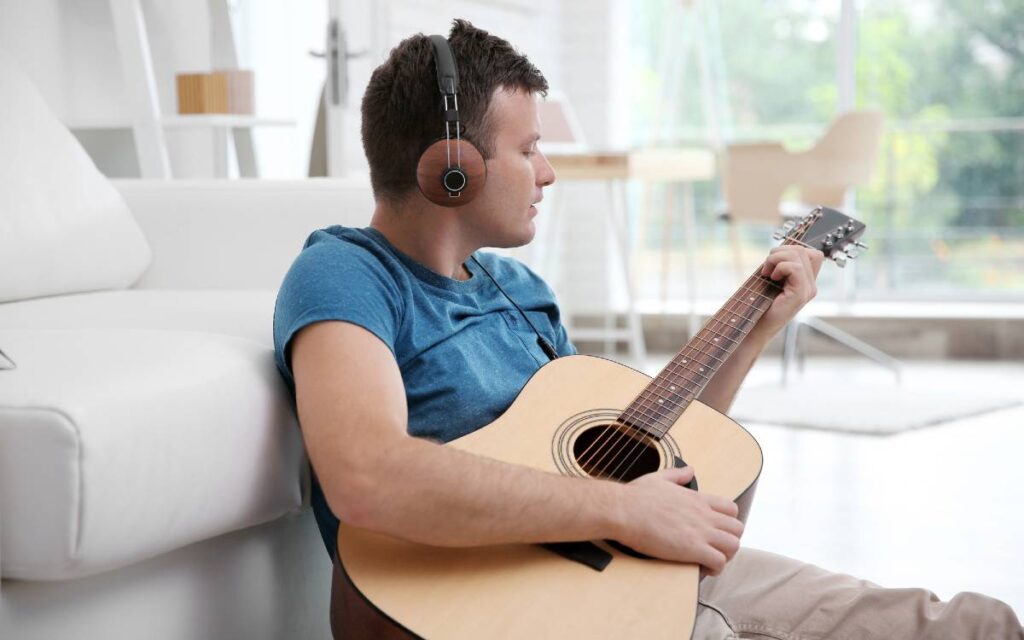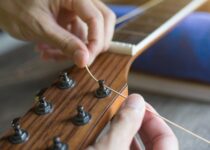Some people can sing and play guitar, but not both at once. The following are some simple tips to help you learn this sought-after skill.
- Pick a simple song
- Know your basics for both skills
- Actively listen to the song you’re learning
- Learn the guitar parts separately first
- Play with a metronome
- Hum the melody before learning the lyrics
- Learn the lyrics by heart, so you don’t have to read at the same time
- Play slowly
- Change the key to suit your voice
Playing guitar and singing is a skill that many new musicians hold in high esteem and is a crucial part of the guitar journey for soloists. Many guitar players can sing or play guitar perfectly but find it difficult to do both simultaneously. Yet, it is an achievable goal with some regular practice. Here are 15 tips to help you learn how to sing and play guitar at the same time.
Post Contents
How to Sing and Play Guitar at the Same Time
1) Start by Picking a Simple Song
Your favorite songs may have complex strumming patterns or vocal melodies. Although you’ll want to sing and play them eventually, it’s not usually the best place to start.
Like any new music skill, mastering the basics first is much more conducive to quality learning. So you should stick to songs with a simple rhythm, vocal line, and chords.
Even if you have mastery of playing guitar for complex pieces, pick an easy guitar song. Using a difficult song will frustrate you, which can cause you to give up.
This process aims to improve your multitasking skills, and it requires all of your concentration. So, if the chords or the vocal lines are second nature already, you’re halfway there.
Identify simple guitar chord songs so you can nail the vocal and guitar parts and build up from there. Preferably choose a piece with three or four chords in total.
2) Know the Basics of Playing Guitar

It would make sense to be able to use one skill before mastering both simultaneously, right?
At the very least, you should be able to transition between chord changes without thinking about it to be able to sing and play at the same time.
If you’re not quite up to that point yet, you should practice the song in separate parts. Practice transitioning from one chord to the next chord every day until you get a better grasp of it. You could start learning the singing part too. It will seem easier to meld them together if you’re already comfortable with both.
3) Actively Listen to The Song
The song you have chosen is simple, but do you really know it? Listen to the song repeatedly. Even experienced performers get tripped up playing songs when the melody and lyrics change up slightly during verses.
You may end up trying to fit too many or not enough syllables into a phrase which will make you think you’re unable to play and sing at the same time when in fact, you’re just getting the song wrong.
Listen carefully to where the chord changes in relation to the song lyrics. Finding the downbeat for the first chord in each bar will help you nail the transitions.
4) Learn The Guitar Part
If you’ve picked a song you already know the words to, then learning the guitar part is all you have to do. If you have to learn the vocals, it’s still best to master the guitar part first.
As mentioned earlier, applying both skills at the same time will be much easier if your guitar playing is already fluid.
Once you feel comfortable, practice some more. It may get boring, but if you’re bored with it, that means you find it too easy. And when it’s easy, you won’t have to think about it while you’re singing the melody to your chosen piece. Ergo, melding the two skills will come a lot more naturally.
It’s a good idea to play along with the song while learning the guitar part and not just use tab. You’ll subconsciously identify where the chord changes are in relation to the singing. If you’re actively trying to do this, it will be even more beneficial when you start singing along.
5) Confirm Your Mastery
This step is optional. It is to check how embedded the chords and strumming pattern are for you in your muscle memory.
Try playing the chords while having a conversation or watching tv. If you don’t have to concentrate on the guitar at all, then learning to sing at the same time should be a piece of cake.
6) Use a Metronome

Using a metronome to maintain a steady rhythm is more of a general piece of advice for learning guitar, but it plays particularly well into the skills we’re discussing.
Learning to combine singing with your guitar skills is all about timing. A metronome’s sole job is to help musicians stay in time, so it’s the perfect tool for practicing with.
Using a metronome will also allow you to slow the tempo down when you incorporate simultaneously playing guitar while singing. A slower tempo will make it much easier, and you can slowly build the speed up from there.
If you don’t have a metronome, there are plenty of free apps for your phone you can use.
(possibly an affiliate link for a metronome or soundbrenner watch here i.e. “or you can buy one here”)
7) Listen and Play Along With the Song Again

You’re probably sick of the song now. But, it’s important to stress just how much more comfortably you’ll learn to sing and play once you’ve gained a level of familiarity.
Once you’ve played with a metronome to dictate your rhythm, it’s wise to revisit the real thing so the melody is fresh in your mind. Listen to the entire song, then listen to it again as you play along.
8) Hum the Melody as You Play Guitar
Humming the melody as you strum your guitar will ease you into the process of singing and playing your guitar.
As you hum, you will notice the places that need a chord change, and this will be helpful when you eventually play guitar while singing simultaneously.
Even though you don’t get the lyrics yet, focus on getting the song’s melody right. Try to go from the start to the finish of the song successfully. Once you are satisfied, you can move to the vocals part.
9) Memorize the Lyrics – and SING!

Just like practicing the chords constantly so they’re second nature, the same thing applies to the lyrics.
It’s much more effective for your concentration if you’re not distracted by reading them while singing.
Take every opportunity to sing, sing while doing your house chores, when in the shower, etc. Remember, as you’re singing simultaneously and doing something else, you are practicing multitasking. With the lyrics memorized, you will be able to sing without fumbling.
When you can sing the song, confirm that you are using the right vocal melody and tempo. Don’t hesitate to listen again and repeat to hone your singing and playing. In addition, you may take time daily to carry out singing exercises.
10) Replace The Humming With Actual Lyrics
At this point, you have mastered the guitar part of the song; you know the lyrics by heart and can hum while you play your guitar. Now you need to use the actual lyrics instead of humming.
Hopefully, by this time, it all clicks for you. Don’t be frustrated if not. Try playing along with the song, but don’t bother strumming. Just make the chord shapes with your fretting hand and sing. Try this a few times.
Then play muted strums. You can mute the strings with your fretting hand and strum and sing.
11) Add The Chords
If playing music while singing is still a bit challenging, you can play one chord at a time as you sing the lyrics over each chord. Repeat each phrase as many times as you need to, and remember to tap your feet with the beat.
Eventually, you will become comfortable and can sing and play the song without any hiccups.
Try to go back to playing without the backing of the song and move back to the metronome to keep your rhythm.
12) Slow It Down
Slowly work your way through the song so that you can identify the problematic areas and iron them out. Slowing down will help you master playing guitar and singing. You will realize that the more you repeat the song, the faster you can sing and play guitar and will be playing at full speed in no time.
13) Changing The Key
Sometimes you’ll master the skill of singing and playing, but there are just some notes you can’t hit.
Try transposing the key to one that is more comfortable for you to sing in. You can use a capo for this and still play the same chord shapes. A good rule of thumb is to try the capo on fret 3 or 5 and see which is better.
Rinse and repeat with other frets until you find the perfect key for you to sing along with.
14) Practice and More Practice

Now you should be singing and playing a song. Great! But, can you do that with a bunch of different songs straight away? Probably not.
You should repeat this process with other songs until learning to sing and play guitar comes naturally to you. Pick a genre you like, but one where there are many simple songs – many folk guitar songs are good options. You could try targeting songs with similar strumming patterns or keys to start with, then move on to more difficult ones.
Make sure to do this through regular, consistent practice, even if it’s only a few minutes of guitar practice a day.
15) Sing and Play Guitar for Real
Once you’ve mastered quite a few different songs in this manner, you should be able to play and sing many songs on the fly just by following tabs or chord charts.
By the time you can do this, you’re ready to start playing solo gigs (provided you’re a decent singer). So, get out there and make some money with your art.
Throw All The Tips Out The Window
Every person learns differently, and there’s no one correct method to learn and sing and play guitar at the same time. An alternative approach to learning to combine these skills could be:
- Lookup a decent chord chart
- Single strum the chords while singing along to the lyrics in front of you
- Slowly start to incorporate proper strumming patterns instead of single strums
Although this method has a lot fewer steps, you’re much more likely to run into timing issues or to play the song incorrectly. Yet, if “close enough is good enough” applies to you, you could save a lot of time even though it may hurt your progress in the long term.
Tips to Make The Process Smoother
Here are more tips that might be helpful if you are struggling with some of the steps above.
Develop a Habit for Practice
Set aside five minutes daily to practice the section that poses the most challenge. Repeat the same part over and over every day for a week, and you will create a habit. Just five minutes is enough to help you practice playing guitar and singing. Longer is obviously better, but don’t put too much pressure on yourself.
Learn to Keep Playing When You Make a Mistake
If you mix up words or chords, your audience is not likely to notice it unless you make a great deal out of it. It is just a different part of the song; they might even think you are spicing up the performance.
Go on with the performance even after you make a fluff. Stopping will interfere with the flow of the song and will thus draw the crowd’s attention. Making mistakes is a part of learning too, so don’t feel awkward about it.
Learn to Switch Your Focus Between Guitar Playing and Vocals

Some songs have guitar fills between the vocal lines. Others will have difficult notes that require special attention and a lot of breath behind them. You’ll need to be able to switch your focus between your instrument and your voice.
This should come naturally eventually, but for the time being, you should make a conscious decision in your mind for certain pieces of music.
Complex Songs Require More Practice and a Solid Foundation
You must simply put in the work if you want to sing over complex riffs; it is the only way to achieve this automatically. You will have to be dedicated, practice more often and concentrate intensely during practice.
Daily Vocal Exercises to Help You Sing and Play Guitar at the Same Time
We’ve covered a lot about mastering the guitar parts in this guide, but singing is often the more difficult skill to master. Let’s take a look at a simple way to move the needle for improving your vocals.
Just like an athlete takes time to warm up before their game, many singers need to warm up their voices before a performance or rehearsal.
Below are five simple voice exercises that will take roughly 10 minutes but help you sing for extended periods, which is very important when you’ll be spending hours learning to sing and play simultaneously.
Lip Buzz
This lip buzz exercise is carried out by vibrating your lips together. At first, you can do it without a pitch. This exercise will help build up your breath support and stamina while singing.
Try adding a pitch; hold your lip buzz for 3 to 5 seconds. Change the pitch upwards, downwards, or stay on one note. You will experience tickling sensations either in your nose, forehead, cheeks, or other resonators.
If you find it challenging to make the buzzing sound, place your index fingers on the center of your cheeks or roll your tongue.
Solfege
You must have already come across the “Do Re Mi Fa Sol La Ti Do”, known as the solfege if you’ve seen or heard a recording from The Sound Of Music. Sing the solfege as you change the scale up or down as you concentrate on listening to each pitch and matching it with your voice. You could also practice your guitar scales while doing this
“Mah-May-Me-Mo-Moo”
The next warm-up exercise is to sing “mah-may-me-mo-moo”. Sing as you gradually change the notes. Ensure that you pronounce all the “M’s”. Start with the low notes as you slowly increase the pitch.
Relax as you do this warm-up and concentrate on your intonations. Try to see if you can sing “mah-may-me-mo-moo” all in one breath.
“I Love to Sing”
This singing exercise will help improve your range because it includes an arpeggio. Smile, start with a low note as you go high, then start all over again. It will help to sing as you smile as smiling helps to develop a clear and bright sound.
The Siren
You will enjoy this exercise, and that is why it was saved for last. The siren is the easiest vocal exercise of all the vocal warm-ups; all you need to do is imitate the sound of a fire engine passing by. Go through the different ranges of notes, and if you accomplish singing all high and low notes, your vocals are in good shape.
Keep It Up
Learning how to sing and play guitar can be a long and frustrating process, but you’ll get there with some patience and practice. Don’t get disheartened, and try revisiting any steps that you get stuck on.







